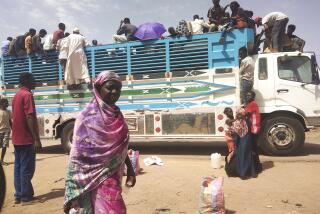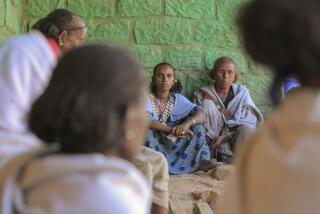30 Million May Feel Impact of Southern Africa Drought : Disaster: Crop losses range as high as 90% and thousands of cattle are dead. Some countries face unrest.
- Share via
DAVEL, South Africa — Koos Durr knelt on a patch of the fertile soil that for years has put the milled white corn known here as pap on the tables of millions of black families in southern Africa. His chapped hand grasped a stalk, which crumbled into dust at his touch.
“If we can survive this year,” the 54-year-old farmer said later, lighting a Gold Dollar cigarette, “then I think we will be able to stay in farming. But this year is our crossroads. Our future depends on what El Nino does.”
One of the worst droughts in African history--even more devastating than the 1984 drought in Ethiopia and Sudan--has blotted out most of the grain crop across a wide area of southern Africa, from Zambia and Malawi to Zimbabwe and South Africa.
Hundreds of farm workers in South Africa already have been laid off and evicted from their homes. Zimbabwe is plagued with food and water shortages. And tens of thousands of cattle have starved to death in the region.
The drought, a result of the El Nino phenomenon that has created unseasonable weather worldwide, has caused crop losses ranging from 50% to 90% in southern Africa. And those failures will affect more than 30 million Africans over the next year, the U.S. Congress was told recently.
About 12 million metric tons of food will have to be imported to prevent mass starvation, and, in countries such as Zimbabwe and Malawi, serious political instability. In ordinary years, only about 2 million tons of imported food is needed in the region.
“Only a massive international relief effort will avert widespread food shortages and famine,” the United Nations Food and Agriculture Organization declared recently in a statement from its Rome headquarters.
Foreign governments and aid agencies say large-scale loss of life is not necessarily inevitable; they already are arranging to get food to ports on the southern tip of the continent. The United States has pledged about $235 million in food aid.
But the impact of the drought is just beginning to be felt now, in the midst of the traditional harvest time. The rainy season passed with barely a shower, and fields of stubbled corn stalks bake beneath the cloudless blue skies of the Southern Hemisphere autumn.
Millions of acres that once produced food are being harvested for cattle feed; millions of others cannot be salvaged. And the long, dry winter is fast approaching.
Aid agencies say the relative economic prosperity of the region may prevent starvation on the scale seen in more disadvantaged countries such as Ethiopia in the mid-1980s. But the last stocks of grain are disappearing from store shelves in much of the region, and officials say the worst is yet to come.
“It’s like a slow-moving film,” the U.S. Agency for International Development told Congress recently. “You know it’s coming, but it takes a while for it to happen.”
The State Department has warned that drought-induced economic hardships could trigger civil unrest in countries with fledgling multi-party democracies, such as Zambia, and other politically fragile countries such as Malawi, Zimbabwe and South Africa.
“A political settlement (in African countries) will need to be strongly reinforced by economic growth if it is to succeed,” Jeff Davidow, acting assistant secretary of state for Africa, recently told Congress.
The drought has hit hardest in the economic powerhouses of the continent, Zimbabwe and South Africa, which usually export grain to their neighbors.
It also has devastated crops in Malawi, a country of 9 million people that supports 1 million refugees from war-racked Mozambique. Economic woes in Malawi have triggered some of the first public resistance in decades to the government of H. Kamuzu Banda, the self-appointed president for life.
In Mozambique, 17 years of civil war has created several million deslocados , or dislocated people, for whom a famine would be fatal. The Mozambique government has warned that more than 3 million people, or a fifth of the population, could starve to death in the next year.
In Zimbabwe, where the harvest is 10% of normal in many areas, children are fainting at schools and up to a fourth of the schools may soon close because of a lack of water, according to World Vision, the California-based aid agency. And 90,000 head of cattle, unable to find green pastureland, have died since December.
“The reality is that this is a very severe drought that will take many lives, especially (those of) children and the very old,” said Backson Sibanda, field director for World Vision in Zimbabwe.
Food shortages already are reported throughout Zimbabwe. The situation there has been exacerbated by the government’s 2-year-old effort to revive the country’s economy. That program has caused a 75% drop in the value of the Zimbabwe dollar and a sharp rise in the cost of living.
When thieves recently broke into the home of journalist Kingsley Kubeyinje, in Harare, Zimbabwe’s capital, they stole soup, sugar, rice and goat meat--and ignored the television set and video recorder. “This is all because of the drought,” said Kubeyinje, who works for the News Agency of Nigeria.
Deliveries of imported food to landlocked Zimbabwe, from ports in South Africa, have been hampered by logistics. American officials say food imports will have to quadruple to meet the demand, but Zimbabwe lacks the trucks to transport even half that much grain.
Zimbabwe President Robert Mugabe, whose popularity is at its lowest point since he took power after independence in 1980, has said that 2.8 million of the country’s 10 million people have applied for government aid because of the drought. And he expects the figure to soon rise to 4 million--or 2 of every 5 people in the country.
“All of us have a duty to ensure that none of our people will starve,” Mugabe told a poorly attended Independence Day rally in Harare last month.
In South Africa, the breadbasket of the region, crop failures have come in the midst of an economic recession. And experts say the drought will render 80,000 farm workers--virtually all of them black and without union protection--jobless. Many of those farm workers live on the edge in the best of times, and most earn less than $60 a month.
Farm worker layoffs already have begun, and some of the thousands who live on white-owned farms have been evicted. Large sugar and cotton mills, and other related industries, have been forced to close, leaving many out of work. And food prices are expected to rise sharply in coming weeks.
“The situation is serious and it is going to affect South Africans in all walks of life,” said Koos du Toit, chief economist of the South African Agricultural Union, which represents farmers. “At best, it will take a whole year for the situation to improve.”
Operation Hunger, a private aid agency in South Africa, already is feeding 2 million people in the country and is receiving 5,000 new applications a week for help. By June, it says, 250,000 more people will be needing food handouts.
In the Orange Free State province, where crop losses of 70% and higher are reported, rivers that have carried water continuously for 30 years are dry. And Operation Hunger has seen a threefold increase in requests for assistance, with 20,000 out-of-work farm laborers joining the food lines in recent weeks.
Mpho Mashinini, deputy director of Operation Hunger, said the agency has received reports of several children dying of malnutrition. And Mashinini said one man was killed when his family started fighting over their food supplies.
Of the $350 million the South African government has allocated for drought relief, only $7 million will go to the country’s 1 million farm workers. The remainder is destined for farmers, most of whom are white, to prevent them from going bankrupt.
“The time ahead is going to be rough,” predicted Johann Erasmus, head of the government’s Institute of Soil, Climate and Water. “Agriculture in South Africa is in a state of crisis. Farmers’ debts are astronomical and the weather is not complying.”
Some of the worst-hit areas in South Africa are in the nominally independent black homelands, which were created as a repository for blacks by the white government. Tens of thousands of subsistence farmers in the homelands face crop failures and have no access to government assistance.
On Koos Durr’s 14,500-acre farm, about 120 miles east of Johannesburg, the annual harvest has yielded only 40% of his usual crop of maize, or white corn, and half the usual crop of potatoes. Maize is ground into a flour-like powder that provides the staple food for most of southern Africa.
“Most of the farmers around here are very depressed about the drought,” Durr said. “They wonder how can they carry on next year to farm. Will they be able to farm? If they could get a good price for their farm, I’m sure they’d sell. But we all know, at this stage of the game, no one is interested in buying.”
Durr has 60 full-time farm workers, who support 300 family members who also live on his farm. Some neighbors already have laid off seasonal laborers, who come in the thousands from the homelands to work the fields.
Durr hasn’t had to lay off anyone, at least not yet.
“We’ll try to keep them on, but we may not be able to,” Durr said, adding, “Some of us farmers won’t be able to pay last year’s costs. We won’t have money for living. We won’t have money to put in for the next crop.”
Durr thinks the government aid money will help him put in a crop again next year, but there’s no guarantee for the year after that if the drought continues. Meantime, his tractors and trucks grow older and more expensive to maintain, and he hasn’t the money to replace them.
Durr’s family has farmed this land since 1916, and he’s only seen one drought--in 1966--that approached the severity of this year’s. But this time, farmers are in a much weaker position financially, having endured years of 15% annual inflation and interest rates of 20% and higher.
The sheer scale of the devastation leaves Durr shaking his head.
“You should have seen our grazing field last year. It was this high,” he said, raising a hand two feet above his desk. “Now it’s like this,” he added, holding his thumb and index finger an inch apart.
More to Read
Sign up for Essential California
The most important California stories and recommendations in your inbox every morning.
You may occasionally receive promotional content from the Los Angeles Times.














